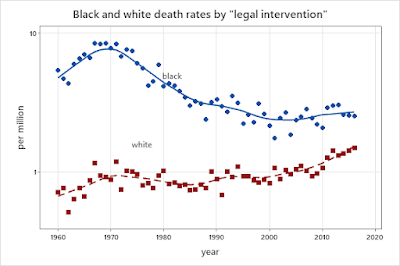The New York Times recently had a story called "Pain in children is often ignored. For children of color, it's even worse." That story mentioned "an often-cited study published in 2016 in the Proceedings of the National Academy of Sciences" on pain treatment recommendations. It turns out that I blogged about that article a few years ago. When I checked, I found that it had 1404 citations in Google Scholar. Articles in medicine and public health tend to be cited at high rates, but that's still a lot. However, that's not what this post is about, it's just how I got started.
I read one of the articles that cited the PNAS paper and found a reference to a study of trends in killings by police between 1960 and 2010. There are several recent data sets on police killings, but I didn't know that there was any historical data at the national level, and assumed that there wasn't any (see this post for some data on New York City). The study used data from death certificates, which include a category for "legal intervention" (formerly "injury by intervention of police"). They just considered men aged 15-34, so I went back to the original data. The 1968-2016 data are available from the National Center for Health Statistics, which has a convenient online tool, and the older data are in annual issues of Vital Statistics of the United States. The basic figures:
For example, in 1960 125 white people and 119 non-whites were recorded as dying from "injury by intervention of police." There were about 175 million whites and 17 million blacks, giving about 0.7 deaths per million among whites and 5.4 million among blacks. The black rate is slightly overestimated, since some of the non-whites were not black, but the effect is probably small (in 1968, they shifted to black, white, and "other race," and there were only 3 in "other race").
The rate of deaths among blacks rose in the 1960s, but then declined and has remained about the same in the 21st century. The original study just reported data with minimal interpretation, but the paper that cited it (published in the New England Journal of Medicine and cited 478 times since its publication in 2021) said "the late 1960s also saw a massive spike in police killings of Black men," and didn't mention the decline after 1970.
The rate among whites looks like it has increased pretty steadily--in order to see it more clearly, here's the same graph with a log scale:
If you look at the ratio of black to white death rates, it shows a long-term decline, from more than 8:1 in the 1960s to less than 2:1 in the latest years for which data are available (2014-16).
Methodological appendix: The death certificate data shows only about 500 deaths from "legal intervention" in the mid-2010s. The data on deaths from police, which start at about that time, show at least 1,000. My guess is that death certificates sometimes just give the physical cause of death--e. g., say that a person died from a gunshot wound and don't mention who fired the shot. The rate of incomplete reporting could change over time and differ among races, and the racial differences could change over time. So clearly these data aren't definitive, but they have potential. Someone should do a more thorough analysis.



No comments:
Post a Comment